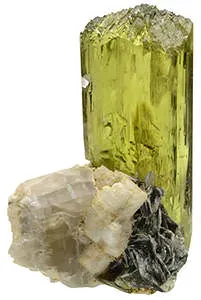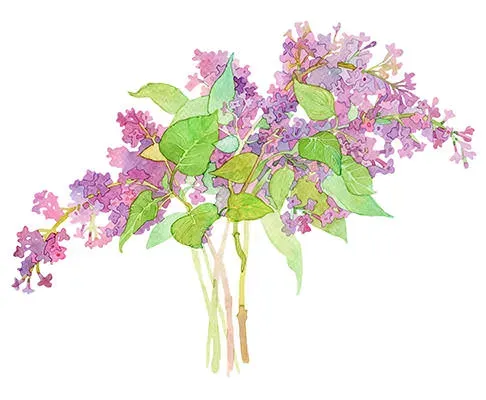 Spodumene is a lithium aluminum silicate and a member of the monoclinic pyroxene group, similar to jadeite. Its name means ashen because this mineral is often grayish white or ash gray. In the past, spodumene was also called triphane, a word of Greek derivation meaning three aspects, due to its clear trichoism. Spodumene was discovered in 1877 in Brazil. At that time, the only gem quality spodumene was yellow green in color, and it was sold as chrysoberyl. Two years later, hiddenite, a green variation of spodumene (colored by chromium) was discovered in North Carolina, and a lilac/ pink variation (colored by manganese) named kunzite, was discovered in Connecticut. These two stones were then recognized as the pink and green varieties of spodumene. Green hiddenite is named after W. E. Hidden, a superintendent at the mining company in North Carolina who discovered the stone in 1879. Lilac-pink kunzite is named after the American gemologist G. F. Kunz, who first described it in 1902, when gem quality kunzite was discovered in California. Kunzite and hiddenite are also known to be found in Madagascar and Myanmar, where rare blue spodumene has also been found.
Spodumene is a lithium aluminum silicate and a member of the monoclinic pyroxene group, similar to jadeite. Its name means ashen because this mineral is often grayish white or ash gray. In the past, spodumene was also called triphane, a word of Greek derivation meaning three aspects, due to its clear trichoism. Spodumene was discovered in 1877 in Brazil. At that time, the only gem quality spodumene was yellow green in color, and it was sold as chrysoberyl. Two years later, hiddenite, a green variation of spodumene (colored by chromium) was discovered in North Carolina, and a lilac/ pink variation (colored by manganese) named kunzite, was discovered in Connecticut. These two stones were then recognized as the pink and green varieties of spodumene. Green hiddenite is named after W. E. Hidden, a superintendent at the mining company in North Carolina who discovered the stone in 1879. Lilac-pink kunzite is named after the American gemologist G. F. Kunz, who first described it in 1902, when gem quality kunzite was discovered in California. Kunzite and hiddenite are also known to be found in Madagascar and Myanmar, where rare blue spodumene has also been found.
 Kunzite and hiddenite are very popular with collectors, although perfect cleavage makes them fragile gemstones. Spodumene is a gemstone relatively new to widespread jewelry use. The most popular varieties of the stone are kunzite and hiddonite. Care must be taken when wearing spodumene as it can break easily if it receives a sharp blow from certain directions. For this reason, the stone isn't recommended for rings unless it's set in a protective mounting. Aside from its fragility, spodumene is a great choice for dramatic, contemporary jewelry as its low cost makes it a good choice for large stones. Be aware however, that it can be confused with and sold as the much more expensive
Kunzite and hiddenite are very popular with collectors, although perfect cleavage makes them fragile gemstones. Spodumene is a gemstone relatively new to widespread jewelry use. The most popular varieties of the stone are kunzite and hiddonite. Care must be taken when wearing spodumene as it can break easily if it receives a sharp blow from certain directions. For this reason, the stone isn't recommended for rings unless it's set in a protective mounting. Aside from its fragility, spodumene is a great choice for dramatic, contemporary jewelry as its low cost makes it a good choice for large stones. Be aware however, that it can be confused with and sold as the much more expensive ![]() topaz, tourmaline, or
topaz, tourmaline, or ![]() beryl. It can also be mistaken for synthetic corundum or spinel.
beryl. It can also be mistaken for synthetic corundum or spinel.
 Spodumene frequently occurs as long, large, unevenly terminated, flat sided crystals, often with longitudinal striations. Some of these crystals are among the largest in the mineral world. Crystals a few meters in length, weighing over a ton, have even been found. Most often, crystals are a faintly green, nontransparent whitish gray- hence the name which refers to ash. Violet pink, bright green, yellow green, or yellow specimens are much less common and transparent crystals of these are used as gems. Transparent crystals have vitreous luster and marked pleochroism. The semi-opaque crystals look almost pearly and have easy prismatic cleavage. Kunzite is a beautiful brilliant stone, which occurs in lilac, pink and violet shades. Kunzite is distinctly pleochroic- when the gem is turned; different shades of pink and violet are displayed. The pink color may fade with time, or with exposure to light and heat, but some material is irradiated to intensify it. Because of its sensitivity to light, the stone has been become known as an evening stone. Kunzite is a hard stone, but is nonetheless brittle and difficult to cut. Hiddenite is a more rare variety of spodumene that comes in light green or yellow green varieties. Emerald green varieties are sometimes found, but are very scarce. As with kunzite, it is hard but brittle, so care must be taken when wearing this stone. It is also strongly pleochroic, like kunzite, showing green, bluish green, and yellowish green when viewed from different directions. Its color will also fade with exposure to heat. Spodumene has a hardness of 7, and a vitreous luster. It occurs in a wide range of colors, all pale, but very clear and brilliant.
Spodumene frequently occurs as long, large, unevenly terminated, flat sided crystals, often with longitudinal striations. Some of these crystals are among the largest in the mineral world. Crystals a few meters in length, weighing over a ton, have even been found. Most often, crystals are a faintly green, nontransparent whitish gray- hence the name which refers to ash. Violet pink, bright green, yellow green, or yellow specimens are much less common and transparent crystals of these are used as gems. Transparent crystals have vitreous luster and marked pleochroism. The semi-opaque crystals look almost pearly and have easy prismatic cleavage. Kunzite is a beautiful brilliant stone, which occurs in lilac, pink and violet shades. Kunzite is distinctly pleochroic- when the gem is turned; different shades of pink and violet are displayed. The pink color may fade with time, or with exposure to light and heat, but some material is irradiated to intensify it. Because of its sensitivity to light, the stone has been become known as an evening stone. Kunzite is a hard stone, but is nonetheless brittle and difficult to cut. Hiddenite is a more rare variety of spodumene that comes in light green or yellow green varieties. Emerald green varieties are sometimes found, but are very scarce. As with kunzite, it is hard but brittle, so care must be taken when wearing this stone. It is also strongly pleochroic, like kunzite, showing green, bluish green, and yellowish green when viewed from different directions. Its color will also fade with exposure to heat. Spodumene has a hardness of 7, and a vitreous luster. It occurs in a wide range of colors, all pale, but very clear and brilliant.
 Spodumene is a typical mineral of pegmatite's, particularly those rich in lithium. It is found in the United Kingdom, Sweden, Brazil, Madagascar, Myanmar, Canada, the former USSR, Mexico, and the United States, in South Dakota, Connecticut, New Mexico and Massachusetts. To properly take care of your spodumene, avoid exposure to any sort of acids, heat, ultrasonic cleaners, and rough handling.
Spodumene is a typical mineral of pegmatite's, particularly those rich in lithium. It is found in the United Kingdom, Sweden, Brazil, Madagascar, Myanmar, Canada, the former USSR, Mexico, and the United States, in South Dakota, Connecticut, New Mexico and Massachusetts. To properly take care of your spodumene, avoid exposure to any sort of acids, heat, ultrasonic cleaners, and rough handling.